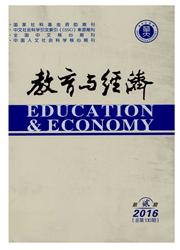

 中文摘要:
中文摘要:
基于扩招以来高等教育规模的发展,对中国大陆31个省(市)1999—2012年普通高校本专科教育规模分布格局及影响因素的空间计量分析发现,中国普通高校本专科教育规模的区域分布差异逐步减小,但依然显著;普通高校本专科教育规模分布存在显著的空间自相关;整体而言,普通高校本专科教育规模的发展受到人口因素、人民生活水平的显著影响;从各个分时段普通高校本专科教育规模影响因素的分析来看,具体影响因素各异,但以人口因素为主因。
 英文摘要:
英文摘要:
According to the development of higher education scale since rapid expansion of college enrollment, this paper has analyzed spatial distribution patterns and main influencing factors of undergraduate education scale by using spatial econometric analysis method based on the statistical data of 31 provinces between 1999 and 2012. Following results has been obtained. Firstly, regional distribution difference of undergraduate education scale gradually decreases, but is still significant. Secondly, there is significantly positive spatial autocorrelation of undergraduate education scale. Thirdly, by taking higher education as a system, the development of undergraduate education scale is significantly affected by population and Engel's Coefficient. From the analysis of the influencing factors of undergraduate education scale, there exists different specific influencing factors but population is the most significant factor in different periods.
 同期刊论文项目
同期刊论文项目
 同项目期刊论文
同项目期刊论文
 期刊信息
期刊信息
